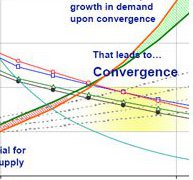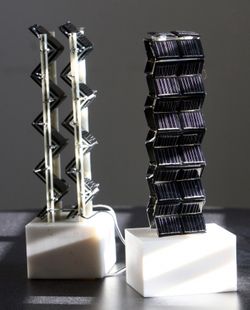Think of this as Volume 16, Number 19 of A-Clue.com, the online newsletter I've written since 1997. Enjoy.

People are writing about a “green tech crash” but that's after the fact. Most U.S.-based green tech companies are flat on their backs and the few that continue to trade, like First Solar (FSLR), are down so far it looks like up.
What the green bears are fearing is an end to federal subsidies of the space between now and 2014. They assume that, since the space was subsidized in 2009, and needed to be subsidized, it must always need to be subsidized, that it lives on subsidy and can't exist without it, that it will disappear without subsidy.
I know the Koch Brothers and their minions across the political world wish that were the case. But that's not the case.

And breakthroughs are continuing. As always in these cases, I just checked the latest headlines before writing this:
- Australian scientists are using a technique called “upconversion” to expand the range of light spectrum harvested by solar panels, which could get the efficiency of solar panels up to 40%.
- Concentrated Solar Power (CSP), which focuses on solar heat as a direct energy source rather than light as a pathway to electricity, is also seeing breakthroughs. 3M and Gossamer Space Frames claim their new technique brings the costs way down, as much as 25% lower, using lighter materials and new films. What's cool about CSP systems is that they can be used to make hot water and they can be made small enough to serve single buildings. We're not just replacing electricity here, but natural gas.
That's just in the last week.

The main force used to try and drive out renewable energy, of course, is the huge investment made in oil and gas production since 2009. The Administration has given folks enough rope to hang themselves. Oil production has risen substantially, and natural gas is now in a glut, with prices hovering just over $2/mcf.
This is unsustainable. Even at $96/barrel, we're reaching the cost of new “last-barrel” production in our new fields. Most gas drillers think they can't making a living below $3.50. As bad as things may seem in the renewable space, they are much worse in the oil patch. And with the Administration having ordered a rise in margin requirements, aimed at reducing market manipulation by speculators, they won't be able to push things back up easily.
Iran has been taken back by the mullahs, production from Iraq is going to increase, new fields are being found in Africa and off South America. Global production and lack of global war is putting a thumb down on oil industry profits, and that's the Kochs' real lifeblood. While everyone else is focused on Congress or Wall Street, it's in small bits of market regulation that the death of the oil barons is being told.

Subsidies? What subsidies? The dawn is still just ahead. Keep driving a little longer and you'll see it.










Just try and get the pigs’ snouts out of the subsidy trough, though.
Just try and get the pigs’ snouts out of the subsidy trough, though.